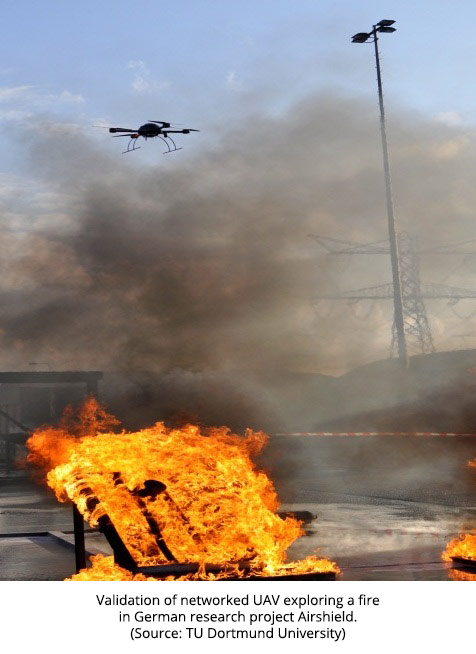 The field of rescue robotics has seen many innovations in recent years, especially unmanned aerial systems (UAS) have proven their benefit in emergency situations by providing situational awareness through flexible and fast exploration. But also ground and underwater robots have been deployed in various incidents. Wireless communication systems are essential for enabling the coordinated action of teams of robots, which may originate from different vendors and rescue organizations. Therefore the standardization of communication interfaces as well as data formats will become a major focus in upcoming years. While safe remote operation of rescue robots needs to be enabled by highly reliable so-called control and non-payload communication, the gathering of sensor data (e.g. high resolution video streams) requires high-bandwidth multi-media communication. Rescue robots may not only act as sensor platforms but also as communications relays to provide communication links to rescue personnel and victims on the ground or water surface (e.g. in case of tele-medicine services in maritime rescue scenarios as being currently explored in the collaborative research project LARUS, which is funded by the German Federal Ministry of Education and Research). In this context the on-going standardization for 5G systems are particularly relevant in the area of ultra-reliable low latency communications (URLLC) as well as Enhanced Mobile Broadband (eMBB).
The field of rescue robotics has seen many innovations in recent years, especially unmanned aerial systems (UAS) have proven their benefit in emergency situations by providing situational awareness through flexible and fast exploration. But also ground and underwater robots have been deployed in various incidents. Wireless communication systems are essential for enabling the coordinated action of teams of robots, which may originate from different vendors and rescue organizations. Therefore the standardization of communication interfaces as well as data formats will become a major focus in upcoming years. While safe remote operation of rescue robots needs to be enabled by highly reliable so-called control and non-payload communication, the gathering of sensor data (e.g. high resolution video streams) requires high-bandwidth multi-media communication. Rescue robots may not only act as sensor platforms but also as communications relays to provide communication links to rescue personnel and victims on the ground or water surface (e.g. in case of tele-medicine services in maritime rescue scenarios as being currently explored in the collaborative research project LARUS, which is funded by the German Federal Ministry of Education and Research). In this context the on-going standardization for 5G systems are particularly relevant in the area of ultra-reliable low latency communications (URLLC) as well as Enhanced Mobile Broadband (eMBB).
The tight regulatory requirements for the operation of unmanned aerial systems in so-called beyond-line-of-sight conditions call for certified reliability of the communication links. Challenges to be tested are for example: range limitations, interference by object causing shadowing and multi-path fading, as well as active interference by other users, in particular in unlicensed bands. In some scenarios, the communication links may be even challenged by intentional as well as unintentional jamming. Despite these communication limitations the robotic systems needs stay in a controlled condition. Potential solution approaches include multi-link communication, which leverages both unlicensed as well as licensed technology (e.g. combinations of LoRa and LTE). In multi-robot environments as well as in case where rescue UAS have to be integrated in the civil air space, standardized smart secondary radar systems will gain importance in the future. They build partially on the evolution of established standards such as ADS-B (Automatic Dependent Surveillance – Broadcast). But as not all UAS will be able to carry their own ADS-B transceiver, the distribution of corresponding positioning data and no-fly zones are expected to be supported also by public cellular networks.
Standardized procedures are required to test the communication links in a reproducible way. The National Institute of Standards and Technology (NIST) has introduced in this context first editions of “Standard Test methods for Response Robots”, which include for example test procedures for ground robots using radio communications in Line-of-Sight range and Non-Line-of-Sight Range. These procedures are expected to be complemented in the future to test involving indoor, urban canyon and interference signal environments, for both ground as well as aerial and maritime vehicles.
On application layer, standardized data formats and interfaces are required to enable interoperability for coordinated robot action. As a starting point one might leverage well established format from the automotive industry. Services defined for the interaction of networked automated vehicles on the road (such as the Cooperative Awareness Messages CAM as part of Vehicle-to-Vehicle communications) may be adapted to rescue robotics and complemented by additional robotic-specific command and control data formats. Also the evolution of the Robotic Operating System (ROS) may lead to standardized data formats to support inter-robot communication.
But these developments are yet in an early stage and international efforts are needed to fully leverage the potential of rescue robotics in the future.
 Christian Wietfeld is a full professor and head of the Communication Networks Institute at TU Dortmund University. He received his diploma and Dr.-Ing. degrees in electrical engineering from RWTH Aachen in 1992 and 1997 respectively. After holding various positions in industry (Siemens, 1997-2005), he joined the TU Dortmund in 2005. Since then, he initiated numerous research projects on the design and performance evaluation of communication architectures, protocols and services, leading to team of 20 full-time researchers working under his supervision. Prof. Wietfeld’s research has been published in around 175 peer-reviewed conference papers, book chapters, contributions to standardization (ITU-T/3GPP/ETSI/OMA) and patents. In 1999 he received an “Outstanding Contribution Award” of ITU-T. Since 2008 he has received 10 Best Paper awards. He is a senior member of the IEEE, editor for the IEEE Wireless Communication Magazine and head of the committee on “Communication Networks and Systems” in the German sister organization of IEEE, ITG. He has co-founded the IEEE GLOBECOM Wi-UAV workshop on Wireless Communications for Unmanned Arial Vehicles together with Prof. J. How (MIT) in 2010. He has a leading role in several UAV-related research initiatives AVIGLE, AIRBEAM and ANCHORS. Currently, he is the coordinator of the German research project LARUS, which aims to develop a UAV-enabled rescue system for maritime emergency incidents. He is a co-founder of various ward-winning start-ups which transfer research results into products and services.
Christian Wietfeld is a full professor and head of the Communication Networks Institute at TU Dortmund University. He received his diploma and Dr.-Ing. degrees in electrical engineering from RWTH Aachen in 1992 and 1997 respectively. After holding various positions in industry (Siemens, 1997-2005), he joined the TU Dortmund in 2005. Since then, he initiated numerous research projects on the design and performance evaluation of communication architectures, protocols and services, leading to team of 20 full-time researchers working under his supervision. Prof. Wietfeld’s research has been published in around 175 peer-reviewed conference papers, book chapters, contributions to standardization (ITU-T/3GPP/ETSI/OMA) and patents. In 1999 he received an “Outstanding Contribution Award” of ITU-T. Since 2008 he has received 10 Best Paper awards. He is a senior member of the IEEE, editor for the IEEE Wireless Communication Magazine and head of the committee on “Communication Networks and Systems” in the German sister organization of IEEE, ITG. He has co-founded the IEEE GLOBECOM Wi-UAV workshop on Wireless Communications for Unmanned Arial Vehicles together with Prof. J. How (MIT) in 2010. He has a leading role in several UAV-related research initiatives AVIGLE, AIRBEAM and ANCHORS. Currently, he is the coordinator of the German research project LARUS, which aims to develop a UAV-enabled rescue system for maritime emergency incidents. He is a co-founder of various ward-winning start-ups which transfer research results into products and services.
